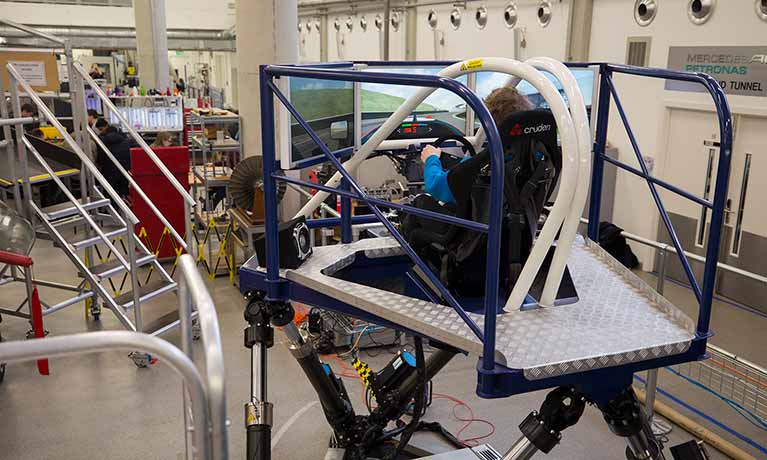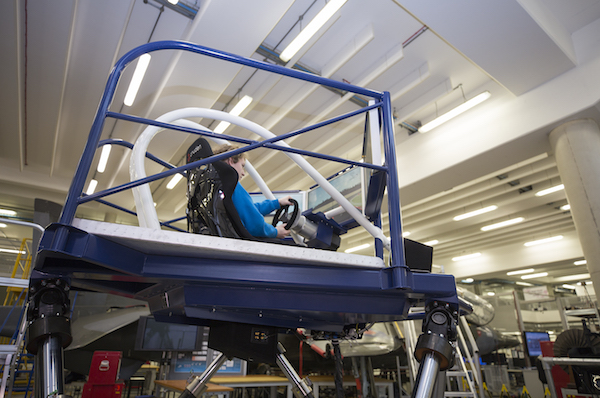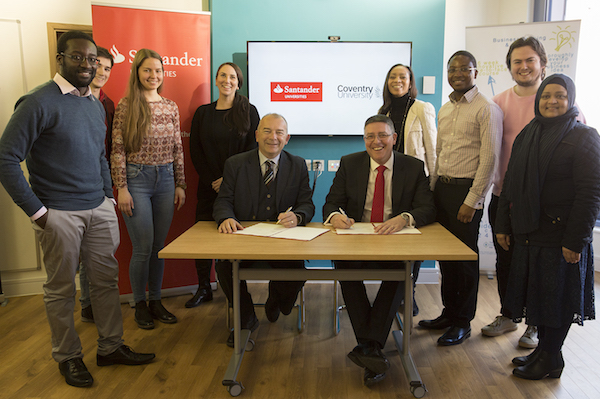Search
Formula One simulator helps students experience life in the fast lane

Tuesday 20 March 2018
Press contact
A new Formula One simulator is giving the next generation of motorsport engineers a realistic experience of working for a race team without leaving their university building.
As the likes of Lewis Hamilton and Sebastian Vettel and their teams prepare for the first race of the grand prix season this weekend, Coventry University students are getting ready for their future motor racing careers by using the hi-tech simulator that has been installed in the Engineering and Computing Building.
It’s the same type of simulator used by some of the top racing teams in the world, and Coventry is one of only two universities in the country to have one.
Lecturers say it will help address shortages of trained data and motorsport engineers by training students to the highest possible standard.
The Cruden simulator allows a driver to experience the thrill, speeds and motion of racing around a grand prix circuit at 190mph, but just without the huge G-forces Formula One racers feel.
A bank of 16 computer screens alongside it – just like a pit wall at a real racing circuit – allows students to analyse the data from the driver’s lap and understand how and where they can adapt their driving to improve their speed and time.
The students have to work at a fast pace, making their calculations in seconds as the driver races around the lap.
As well as suggesting changes to driving, the students can also adapt the vehicle’s specifications and set up, such as its gearbox or wing, to see how that affects its speed, performance and driveability.
Students – ranging from first years to master’s students – are able to use the machine as an integral part of their courses.
And it’s not just about Formula One. The simulator allows students to replicate a range of driving and racing situations, from competing at Spa Francorchamps in Belgium, or Zanvoolt in Holland, to driving along an English motorway or through a city centre.
They can also design their own race tracks and routes to drive along too, and use it to help them develop their own vehicles, such as their Formula Student racing car.
Jeff Peters, senior lecturer in motorsport engineering, said:
Anything you can do with a car on a track you can do with this simulator.
It is giving our students the chance to put theory into action, working on the simulator as if it is a real car in a high pressured and realistic environment.
The simulators includes the same software and calculations used by professional racing teams, so our students can walk, fully prepared straight into their placements or future jobs with racing teams.
There is always a shortage of trained race and data engineers because it is such a tough, intense environment, and this is helping to ensure that the next generations of engineers are keeping racing drivers on the track and as fast as possible.”
Stacey Yates, a student on the MEng Motorsport course, said:
It’s really cool. It’s just like being out in the real world of racing. I did some testing with a race team and, because I already had the experience of using this technology and software, 10 minutes after I walked in through their door I was able to get on with the job.”
Rob Blackburn, who is also studying for an MEng in Motorsport, added:
It’s fantastic, whether you’re driving it or using it for data analysis. It’s very much like working on a real car. It can be very tough when you’re data modelling in a high-pressure environment; this simulator gives us lots of experience in these conditions.”

Image: Student Maciej Sakowicz in the driving seat of Coventry University’s new Formula One simulator.






